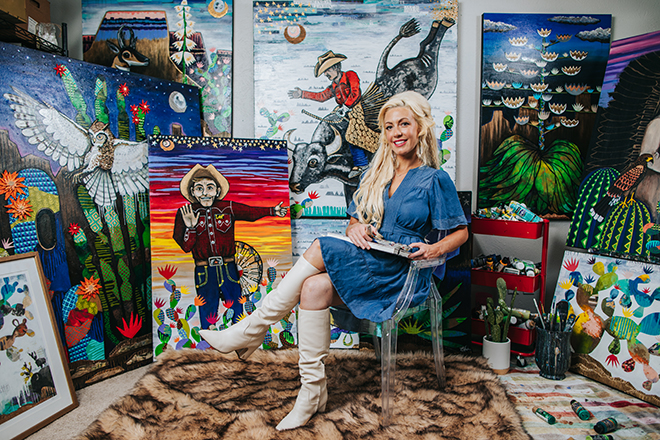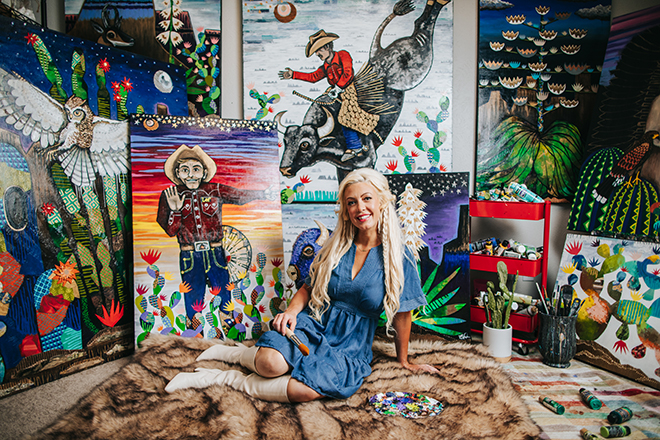
Photography by Kathy Tran
Originally from University Park, Dryden lives and works in her Lakewood condo, painting and constructing pieces in a loft that doubles as her studio. She returned to Dallas in 2013 after years of living around the country, including influential time in Tucson during college at the University of Arizona.
Dryden’s latest body of work, Contemporary Southwest Art, is a reflection of her Texas upbringing and her time farther west.
“I’ve always been drawn to the desert, and you can see a lot of that in my artwork,” she says.
Despite her lifelong love of art, Dryden’s initial career path wasn’t in the arts.
“I wanted to be a veterinarian my whole life,” she says. “When I got to college, I realized how awful I was at math and science. It was going to take a lot of work because I’m so right-brained, so I decided to go with what came naturally to me. I went with art.”

Dryden majored in art education with the idea of becoming an art teacher.
While she does teach a painting night at Blackland Prairie Raptor Center, her focus is squarely on her own art.
Before COVID-19, Dryden split her time between a day job at Neiman Marcus and creating late into the night after her shift. She saved up money selling her art and bought her new abode on the precipice of a pandemic.
“A week later, I got laid off from my job at Neiman, COVID started and it was lockdown everywhere,” she says. “I was nervous about how I was going to keep this place I just bought. I was kind of freaking out.”
Stay-at-home orders worked in Dryden’s favor, though. Now she’s able to crank out pieces in half the time it would have taken her painting only part time.
“I used all the time I could to focus on my art, and it’s been pretty awesome,” she says. “I’ve always wanted to have as much time as I’ve had. It’s been a really positive thing, actually. I can work any hours of the day that I want, and it’s always here, so I don’t have to go anywhere to work.”
Adjusting to full-time artist- ry and the impact of the pandemic on the art industry has been a learning curve, one that forced Dryden to not only work creatively, but think creatively.
“I had to find a way to get [my art] in front of people because there were no more gallery shows or openings,” she says. “They stopped taking new art because they weren’t open, and [galleries] were how I sold a bunch of my art. I took my stimulus check and decided to do something different.”
Dryden invested in several advertisements in a national Southwestern art magazine, Western Art Collector, and was able to show her work in its online gallery. She was featured online in Western Gallery’s “Texas Women” virtual exhibition Oct. 2 and will be featured later this year in the Texas Treasures Fine Art Gallery showing in Boerne. She recently launched a website to sell prints of her artwork. She hand embellishes them for buyers with metallic paint and gold leaf.
Dryden’s art is distinctive not only in its Southwestern subject matter, but in her use of mixed media. When making a piece, Dryden says she might paint on paper, cut out the paper and then put that on the canvas. She might also use newspaper, cardboard or other materials to give the work texture.
“It’s a little bit more intricate than just paint on a canvas,” Dryden says, “but the end result is what makes it unique. I try to focus on the beauty of the Southwest — the bright colors, the animals and the cacti.”
HOW TO HELP SAVE THE DALLAS ARTS SCENE:
- Shop from local vendors and artists.
- Give art with a gift card.
- Participate in programs online.
- Be honest. If three people are participating in a virtual program on one computer, buy three tickets.
- If you’re able, donate to arts organizations and nonprofits. Even small gifts make a difference.
- Share art, resources and fundraisers on your social media platforms.
Her fascination with the region’s landscape and inhabitants is about more than its initial aesthetic beauty. In much of her other work, Dryden has experimented with “things that don’t go together”— female ballet dancers with orchid faces or foxes and rabbits dressed in fine suits. She extended that concept to her technicolor desert scenes.
“It’s the paradox of being beautiful, but also being extremely strong and able to endure whatever life puts in front of them,” she says. “The balance there is interesting to me.”
Continuing to work through COVID, Dryden plans to “just keep painting,” creating as much as she can and growing her business.
“I want people to feel happy when they see my art,” she says. “I want them to see how beautiful nature is and bring a little bit of the outside inside their home. Everything is a piece of art. I feel like people are so busy in their lives— working and taking care of their kids and all the responsibilities of life— sometimes that [beauty] is missed or overlooked. People take it for granted. My art is just capturing that nature and beauty and forcing you to look at it.”





